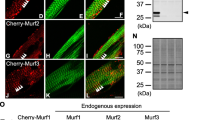Abstract
Congestive heart failure presents a significant medical problem and accumulating evidence indicates that slow relaxation during diastole maybe at least in part be medlated by decreased expression of the gene coding for the Ca2+ ATPase of the sarcoplasmic reticulum (SR). In order to determine if increased expression of the SR Ca2+ ATPase gene leads to alterations in calcium transients and in contractile behavior we constructed transgenic mice overexpressing the SERCA2 gene. Measuring dP/dtmax and dpPdtmin with a 2 French Milar catheter we found a significant Increase in systolic contraction and diastolic relaxation in transgene positive versus transgene negative mice. In addition we constructed adenoviruses overexpressing the gene coding for the Ca2+ ATPase of the sarcoplasmic reticulum. Infacting cardiac myocytes with the adenovirus expressing this transgene led to an accelerated calcium transient. Determining cell shortening and relengthening with a edge detection method indicated that increased expression of the SERCA2 transgene mediated by adenovirus Infection accelerated contractile parameters. In summary increased expression of the SERCA2 transgene leads to an enhancement of cardiac contrectile parameters under in vivo conditions in transgenic mice and in myocytes in cell culture using an adenovirus based approach to increase expression of the SERCAX gene.
Similar content being viewed by others
References
Schocken DD, Arrieta MI, Leaverton PE: Prevalence and mortality rate of congestive heart failure in the United States. JACC 20: 301–306,1992
Braunwald E: Pathophysiology of heart failure. In: W.B. Sanders Co., (ed.) Heart Disease, Philadelphia, PA, pp 393-418
Carafoli E: Intracellular calcium homeostasis: Ann Rev Biochem 56: 395–433, 1987
Morgan JP: Abnormal intracellular modulation of calcium as a major cause of cardiac contractile dysfunction. N Engl J Med 325: 625–632, 1991
de la Bastie D, Levitsy D, Rappaport L, Mercadier JJ, Marotte F, Wisnewsky C, Brovkovich V, Schwartz K, Lompre AM: Function of the sarcoplasmic reticulum and expression of its calcium ATPase gene in pressure overload-induced cardiac hypertrophy in the rat. Circ Res 66: 554–564, 1990
Limas CJ, Olivari M-T, Goldenberg IR, Levin B, Benditt DG, Simon A: Calcium uptake by cardiac sarcoplasmic reticulum in human dilated cardiomyopathy. Cardiovasc Res 21: 601–605, 1987
Hasenfuss G, Reinecke H, Studer R, Meyer M, Pieske B, Holtz J, Holubarsch C, Posival H, Just H, Drexler H: Relation between myocardial function and expression of sarcoplasmic reticulum Ca2+ ATPase in failing and nonfailing human myocardium. Circ Res 75: 434–442, 1994
Arai M, Matsui H, Periasamy M: Sarcoplasmic reticulum gene expression in cardiac hypertrophy and heart failure. Circ Res 74: 555–564,1994
Lorell BH: Significance of diastolic dysfunction of the heart. Ann Rev Med 42: 411–436, 1991
Graham FL: Covalently close circles of human adenovirus DNA and infections. EMBO J 3: 2917–2922, 1984
Milano CA, Allen LF, Rockman HA, Dolber PC, McMinn TR, Chien KR, Johnson TD, Bond RA, Leflkowitz RJ: Enhanced myocardial function in transgenic mice overexpressing the, (32-adrenergic receptor. Science 264: 582–586, 1994
Hartong R, Wang N, Lazar MA, Dillmann WH: Delineation of three different thyroid hormone response elements in the promoter of the rat sarcoplasmic reticulum Ca2+ ATPase gene. J Biol Chem 269: 13021–13029, 1994
Rohrer D, Dillmann WH: Thyroid hormone markedly increases the mRNA coding for sarcoplasmic reticulum Ca2+ ATPase in the rat heart. JBiol Chem 263: 6941–6944, 1988
Rohrer DK, Hartong R, Dillmann WH: Influence of thyroid hormone and retinoic acid on slow sarcoplasmic reticulum Ca2+ ATPase and myosin heavy chain a gene expression in cardiac myocytes. J Biol Chem 266: 8638–8646, 1991
Author information
Authors and Affiliations
Rights and permissions
About this article
Cite this article
Dillmann, W.H. Regulation of expression of cardiac sarcoplasmic reticulum proteins under pathophysiological conditions. Mol Cell Biochem 157, 125–128 (1996). https://doi.org/10.1007/BF00227890
Issue Date:
DOI: https://doi.org/10.1007/BF00227890




